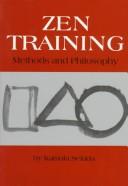Check nearby libraries
Buy this book

First published in 1975, Zen Training has become a classic of Zen literature. It was one of the first books to demystify religion without debunking it, to explain hitherto esoteric practices in lucid, everyday terms. It offers concrete guidelines for practicing zazen, seated meditation. Posture, breathing, the function of the abdominal muscles, muscle tone, and the mechanisms of wakefulness and attention are clearly and scientifically explained, so that one learns what actually happens in doing zazen, why it leads to certain psychological experiences, and what their significance is. There is also a chapter on koans that goes far to clarify what for many has seemed one of the most frustrating and baffling aspects of Zen. Again, the reader is told how actually to deal with koans and how they operate as catalysts of enlightenment. The author also draws many significant parallels between Zen and Western philosophy and psychology, comparing traditional Zen concepts with the theories of being and cognition of such thinkers as Heidegger and Husserl. Zen Training marked a turning point in Zen literature in its critical reevaluation of the enlightenment experience called kensho, which the author believes has often been emphasized at the expense of other important aspects of Zen training. The aim of zazen is seen not as the achievement of such experiences as satori or kensho but as the attainment of absolute samadhi, that condition of utters stillness in which thought is cut off, the mind is empty, yet one is in a state of extreme wakefulness and awareness. Absolute samadhi is considered the precondition of any kensho experience of lasting value, and indeed as "the foundation of all Zen activities." This book also goes beyond the earlier stages of Zen training to describe the more advanced stages: what happens after kensho, and above all, how one lives as well as trains in Zen.
Check nearby libraries
Buy this book

Previews available in: English
Showing 4 featured editions. View all 4 editions?
| Edition | Availability |
|---|---|
|
1
Zen training: methods and philosophy
2005, Shambhala
in English
- 1st Shambhala ed.
1590302834 9781590302835
|
zzzz
Libraries near you:
WorldCat
|
| 2 |
zzzz
Libraries near you:
WorldCat
|
|
3
Zen Training
January 23, 1976, Weatherhill Inc
Hardcover
in English
- 1st ed edition
0834801116 9780834801110
|
zzzz
Libraries near you:
WorldCat
|
|
4
Zen training: methods and philosophy
1975, Weatherhill
in English
- 1st ed.
0834801116 9780834801110
|
aaaa
Libraries near you:
WorldCat
|
Book Details
Edition Notes
Includes bibliographical references and index.
An expanded English version of An introduction to Zen for beginners, originally written in Japanese.
Classifications
The Physical Object
ID Numbers
Community Reviews (0)
Feedback?| December 12, 2023 | Edited by MARC Bot | import existing book |
| January 8, 2023 | Edited by MARC Bot | import existing book |
| August 1, 2020 | Edited by ImportBot | import existing book |
| February 13, 2020 | Edited by MARC Bot | remove fake subjects |
| October 20, 2009 | Created by WorkBot | add works page |















